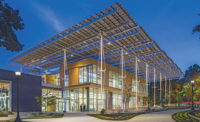The Promise and Pitfalls of Modular Buildings














Off-site construction is most apppropriate for buildings with repetition, including schools, housing, hospitals, multifamily residential, hotels and dormitories. Many recent modular buildings are a mix of site-built, non-repetitive lower floors topped by assemblies.
The B2 drama is serving as a cautionary tale. The 85-member Off-Site Construction Council, formed last year by the National Institute of Building Sciences (NIBS) to advance all types of prefabrication and preassembly, "is interested in learning what works and what does not in all projects that pursue the use of off-site construction," says Ryan Colker, the council's director. "As the case unfolds, we will be looking to understand any role off-site construction had in the dispute."
To the NIBS council, "off-site construction" is the design, fabrication and assembly of building elements at a location other than their installed location. "Off-site construction is characterized by an integrated planning and supply-chain optimization strategy," says the council, in its draft off-site construction glossary.
Permanent modular construction, also known as volumetric or 3D modular, is a subset of off-site. NIBS defines it as "an innovative, sustainable construction delivery method utilizing off-site, lean manufacturing techniques to prefabricate single or multistory whole building solutions in deliverable module sections." PMC buildings are made in a safe, controlled setting and can be framed in wood, steel or concrete. Modules can be delivered with mechanical-electrical-plumbing systems, fixtures and interior finishes.
"The application of manufacturing principles to design and construction enables us to put buildings together in more innovative ways," says Sue Klawans, Gilbane's director of operational excellence and planning and the council's vice chair. "Why bring 2 million individual bricks, studs and wire connectors to the site? Let's reduce that by a factor of 10 or 100."
Off-site construction leaves "many owners, architects and builders confused and sometimes put off by the process," says Ryan E. Smith, chairman of the NIBS council and director of the Integrated Technology in Architecture Center at the University of Utah. "It is not easy for those in their first rodeo."
"Not easy" is an understatement for the first residential rodeo of FCRC and Skanska. Sited up against the two-year-old Barclays Center arena, B2 is already more than a year behind its original December completion date. On Aug. 27, Skanska stopped work at both the site and the FC+Skanska Modular plant, furloughing more than 150 workers and raising the ire of Forest City. Lawsuits have followed.
Skanska is asking for more than $50 million in damages over its $117-million fixed-price contract to cover alleged "commercial and design issues." Forest City, on a campaign to reopen the plant, alleges Skanska has breached its contract after "multiple failures and missteps" that led to "massive delays and cost overruns."
John Erb, vice president of sales and marketing for Deluxe Building Systems Inc., says, "If a project goes awry, it means the team didn't know the process. It's like me trying to perform open-heart surgery tomorrow without any training." Deluxe supplied modules for the 90.5-ft-tall Stack, the U.S. record-holder for the tallest completed modular building.
Factory modular is "a science" and "outsiders" should not venture into the business, which is drastically different from traditional site construction, says Capsys' O'Hara.




-Janine-Pietz_ENRready.jpg?height=200&t=1737072241&width=200)









